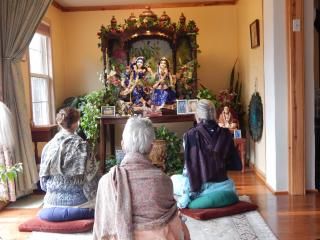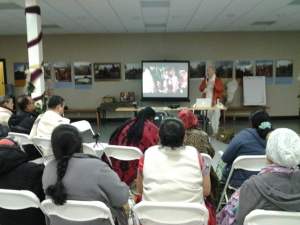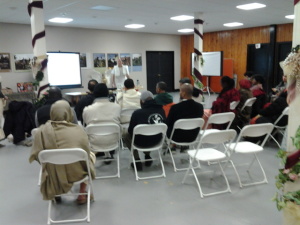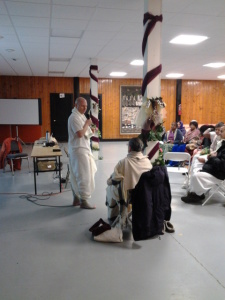Sunday, November 30th, 2014
Nandagram and Vrindavan retreat 2014 (Album 150 photos)
Srila…
→ Dandavats.com

Nandagram and Vrindavan retreat 2014 (Album 150 photos)
Srila Prabhupada: Intelligent men decide to solve all problems by adopting the devotional service of chanting the holy name of the Lord, who is situated in everyone’s heart and who is a mine of all auspicious qualities. Such persons are not within Yamaraj’s jurisdiction for punishment. (Srimad-Bhagavatam, 6.3.26 Purport)
http://goo.gl/eZEtzo
Material Self Knowledge Vs Spiritual Self Knowledge
→ NY Times & Bhagavad Gita Sanga/ Sankirtana Das
Kirtan Mela Malaysia 2014 – Association
→ ISKCON Malaysia Photos
Kirtan Mela Malaysia 2014 – Association
→ ISKCON Malaysia Photos
New Navadwip, ISKCON Honolulu, offering (15 min video)
This…
→ Dandavats.com

New Navadwip, ISKCON Honolulu, offering (15 min video)
This video is dedicated to His Grace Ambarish Prabhu.
ISKCON Honolulu invites you to please come and visit us :-)
Watch it here: http://goo.gl/PJ3BhG
Harinama and preaching programs in Miami, USA (Album 116…
→ Dandavats.com

Harinama and preaching programs in Miami, USA (Album 116 photos)
Srila Prabhupada: Even if in the beginning one chants the Hare Krishna mantra with offenses, one will become free from such offenses by chanting again and again. Papa-ksayas ca bhavati smaratam tam ahar-nisam: one becomes free from all sinful reactions if one chants day and night, following the recommendation of Sri Caitanya Mahaprabhu. (Srimad-Bhagavatam, 6.3.24 Purport)
See them here: http://goo.gl/SJMgv0
Prabhupada Letters :: Anthology 2014-12-09 09:01:00 →
Prabhupada Letters :: 1968
Gita 02.02 – Arya – Spiritual denotation, historical concoction and modern connotation
→ The Spiritual Scientist
Gita verse-by-verse study Podcast:
Prabhupada Letters :: Anthology 2014-12-09 08:56:00 →
Prabhupada Letters :: 1968
Prabhupada Letters :: Anthology 2014-12-09 08:54:00 →
Prabhupada Letters :: 1971
Prabhupada Letters :: Anthology 2014-12-09 08:53:00 →
Prabhupada Letters :: 1971
Prabhupada Letters :: Anthology 2014-12-09 08:48:00 →
Prabhupada Letters :: 1971
Prabhupada Letters :: Anthology 2014-12-09 08:47:00 →
Prabhupada Letters :: 1971
Auspicious Opening of the three new classrooms in Sri Mayapur…
→ Dandavats.com

Auspicious Opening of the three new classrooms in Sri Mayapur International Schoo! (Album 18 photos)
By chanting the Hare Krishna mantra without offenses, one increases his love for Krishna. As stated by Sri Caitanya Mahaprabhu, preme pum-artho mahan: one’s main concern should be to increase one’s attachment to the Supreme Personality of Godhead and to increase one’s love for Him.
(Srimad-Bhagavatam, 6.3.24 Purport)
See them here: http://goo.gl/NOF8pV
Prabhupada Letters :: Anthology 2014-12-09 08:34:00 →
Prabhupada Letters :: 1973
Prabhupada Letters :: Anthology 2014-12-09 08:32:00 →
Prabhupada Letters :: 1973
Fortunate People (US) (Album 278 photos)
Come stroll with me…
→ Dandavats.com

Fortunate People (US) (Album 278 photos)
Come stroll with me down Nectar Lane. Every day I meet fortunate people who appreciate these amazing books. Don’t miss the bliss….click on the pic to see what they have to say! Looking forward to sharing realizations with you!
See them here: http://goo.gl/nvY7KM
Harinama in Singatoka, Fiji (Album 40 photos)
Srila Prabhupada:…
→ Dandavats.com

Harinama in Singatoka, Fiji (Album 40 photos)
Srila Prabhupada: In the sastras it is said that if a person only once chants the holy name and completely surrenders unto the lotus feet of the Lord, the Lord immediately considers him His ward and is always inclined to give him protection. (Srimad-Bhagavatam, 6.2.49 Purport)
See them here: http://goo.gl/MP74mO
The Art of Kīrtan, Part 1 – Introduction
→ The Enquirer
The Art of Kīrtan, Part 1 – Introduction
Kīrtan is the central practice of bhakti-yoga, the spiritual path of devotion. Essentially, bhakti-yoga is anukūlyenānuśilana — an expression of affection.
Kīrtan literally means “celebration.” It is a celebration of affection.
The most important, powerful form of kīrtan is nāma-kīrtan, “celebration of a name.” We celebrate the name of the divine beloved, Śrī Krishna, by glorifying it.
Kīrtan and Art
Music is not necessary for kīrtan, which can just as easily be written or spoken as it can be sung. But music is a particularly powerful way of celebrating something, therefore kīrtan is very throughly associated with music.
One need not be a musician to perform kīrtan, one simply needs to have affection that can be expressed in celebration of the beloved, Śrī Krishna. It is not necessary to be “good” at kīrtan, it is necessary to have love for Krishna.
However, the nature of love is that it is beauty. Love is inherently beautiful. Therefore when one celebrates the name of Krishna, it will automatically be beautiful. To make an effort to increase the beauty of ones celebration of Krishna’s name is itself an act of love.
Imitations of beauty will ring as hollow as high heels in a lonely hallway. Beauty comes naturally to one who has true love. And one with true love naturally wants to be as beautiful as possible for the beloved.
Music of Kīrtan
Therefore it is an act of love to learn a bit about the basics of music, and employ that in one’s nāma-kīrtan. The most sophisticated form of music in human history is Indian music. By comparison, western music, even in its high classical form, is very simple and rudimentary. Indian music, being so sophisticated, allows more freedom of expression and has more emotive power than any other system of music. For this reason, we should prefer to learn Indian music theory to make our Kīrtan more beautiful.
Another reason to prefer Indian music is that it is more sattvika. Because it is so sophisticated and subtle it evokes more clarity and pensivity — the character of sattva. Western music theory, by comparison, is inspiring and stirring — the character of rajas. Items of the sattva nature are more amenable to spiritual application.
Another reason to prefer Indian music is that Krishna reveals his personality through the ancient Indian culture. Therefore the ancient Indian culture has a more direct link to the divine svarūpa than any other form of human culture. Since the whole aim of kīrtan is to become closer with Krishna, it makes sense to evoke the musical culture most closely associated with his dhāma-svarūpa.
Simple Stuff
Although the lyrics of Jayadeva’s Gīta-Govinda and similar outstanding poems have been beautifully set to elaborately sophisticated classical Indian music and dance, for the most part nāma-kīrtan uses “folk” principles, relatively simplified aspects of the classical cannon that everyday people can more easily follow and perform.
I will particularly explain the Gauḍiya approach to kīrtan, which is to say the North East (Bengal-area) approach to it.
Basics of Indian Music
Like all forms of music, Indian music has two primary components: rhythm (tāla) and melody (rāga). In the next set of installments in this series I will explain the basics of tāla. After that I will explain the basics of rāga.
When explaining tāla I will first explain how to clap it. Then I will explain how to express a tāla with cymbals (karatāla), and finally I will show some simple beats to go with the simple tāla on the mṛdāṅga drum.
Tasting and Distributing Krsna Consciousness
Giriraj Swami
 On December 1, in New Dvaraka, Los Angeles, I gave a talk on tasting and distributing Krsna consciousness, in relation to the December book marathon. A transcript follows. . . .
On December 1, in New Dvaraka, Los Angeles, I gave a talk on tasting and distributing Krsna consciousness, in relation to the December book marathon. A transcript follows. . . .
We have again reached December, that most auspicious time of year when the book-distribution marathon takes place. To honor the occasion we shall read two verses from Srimad-Bhagavatam that embody the devotee’s mood in distributing Krsna consciousness.
naivodvije para duratyaya-vaitaranyas
tvad-virya-gayana-mahamrta-magna-cittah
soce tato vimukha-cetasa indriyartha-
maya-sukhaya bharam udvahato vimudhan
“O best of the great personalities, I am not at all afraid of material existence, for wherever I stay I am fully absorbed in thoughts of Your glories and activities. My concern is only for the fools and rascals who are making elaborate plans for material happiness and maintaining their families, societies, and countries. I am simply concerned with love for them.” (SB 7.9.43)
prayena deva munayah sva-vimukti-kama
maunam caranti vijane na parartha-nisthah
naitan vihaya krpanan vimumuksa eko
nanyam tvad asya saranam bhramato ’nupasye
“My dear Lord Nrsimhadeva, I see that there are many saintly persons indeed, but they are interested only in their own deliverance. Not caring for the big cities and towns, they go to the Himalayas or the forest to meditate with vows of silence [mauna-vrata]. They are not interested in delivering others. As for me, however, I do not wish to be liberated alone, leaving aside all these poor fools and rascals. I know that without Krsna consciousness, without taking shelter of Your lotus feet, one cannot be happy. Therefore I wish to bring them back to shelter at Your lotus feet.” (SB 7.9.44)
To distribute Krsna consciousness, we must have Krsna consciousness. These verses are about Prahlada Maharaja, and in a way they are also about Srila Prabhupada, who in his purport expressed his own mood—and about us, how Srila Prabhupada wants us to execute Krsna consciousness. Prahlada Maharaja and Srila Prabhupada were on a very high level of Krsna consciousness, but even on our own level we can experience something of what they experienced, that wherever we are we can get relief from material miseries and anxieties by taking shelter of the holy name. We can joyfully chant in the temple room, in the association of devotees, before the Deities, and in the presence of Tulasi-devi—but one can chant anywhere, even on traveling sankirtana. One can close one’s eyes and chant and hear and no longer be in the material world—actually be with Krsna.
Devotees need that connection with Krsna not just for their own sakes but also for the sake of others. Once, in a meeting with Srila Prabhupada in the Atlanta temple, Svavasa Prabhu asked, “How can we increase our devotion and our desire to distribute more books?” He and the other devotees were eagerly anticipating some special formula to expand their book distribution. Srila Prabhupada didn’t look at them; he looked upward, and they waited in suspense. Finally he said, “If you want to increase book distribution, if you really want, I have only one recommendation. . . . You must chant your rounds uninterrupted. After you begin your chanting, do not stop until you finish.” As Svavasa Prabhu explained, if you win that fight, you will win all day, but if you lose it and allow your mind to carry you to something else, you will have a difficult day.
Svavasa Prabhu still follows that policy. He gets up at two in the morning and chants all his rounds before even coming to the temple for mangala-arati. A while ago I stayed with Vaisesika Prabhu at his home in Burlingame, and his morning program was blissfully intense. He did things that we do every day—and some things that we may do only on occasion—but he did them with so much enthusiasm and so much relish that the practices came to life. I felt, “Wow, that’s what reciting these verses and prayers actually is.” We spoke later about the book he is writing on book distribution, and he said that one of the themes is that the energy to distribute books comes from the overflow of the ecstasy we feel from our spiritual practices, from our own Krsna consciousness.
I’ve also experienced that if you chant your rounds in the morning before going out you will get extra energy and intelligence for your service, and if you don’t, not only may you be a little depleted in your spiritual energy, but you may also be in anxiety about when you’re going to finish your rounds.
So this practice of rising early and chanting all your rounds is very much part of the process of sharing Krsna consciousness with others. In the earlier verse, Prahlada said that he has no anxiety for himself because wherever he is he can merge himself into the nectarean ocean of Krsna consciousness—and that’s true for us as well. Wherever we go we can have that experience of tasting the nectar of Krsna consciousness by chanting the holy names and by reading, studying, and discussing Srila Prabhupada’s books.
So the two—tasting and distributing—go together. Srila Bhaktisiddhanta Sarasvati Thakura said that the best gosthyanandi is a bhajananandi who likes to preach. Gosthyanandi means someone who takes pleasure in preaching and sharing Krsna consciousness with others, and a bhajananandi is someone who takes pleasure in his own bhajana, his own spiritual practices. Prahlada Maharaja exemplifies that principle, because personally he can experience pure bliss anywhere at any time just by chanting and hearing and remembering his Lord. Yet he is not content to go back home, back to Godhead, alone; he wants to bring the krpanan with him.
Krpana is a very significant word. It is discussed by Srila Prabhupada in the Bhagavad-gita, in relation to Arjuna’s admission that he was overcome by miserly weakness.
karpanya-dosopahata-svabhavah
prcchami tvam dharma-sammudha-cetah
yac chreyah syan niscitam bruhi tan me
sisyas te ’ham sadhi mam tvam prapannam
“Now I am confused about my duty and have lost all composure because of miserly weakness. In this condition I am asking You to tell me for certain what is best for me. Now I am Your disciple, and a soul surrendered unto You. Please instruct me.” (Bg 2.7)
Krpana means “miser.” But how does it apply? A miser is someone who has an asset but doesn’t use it. He may have a lot of money but not spend it for any good purpose; he will just hoard it. So, we have this human form of life, which is extremely rare and valuable—valuable because it can be used to realize God. And if we don’t use it for that purpose, we are krpanas, misers.
labdhva su-durlabham idam bahu-sambhavante
manusyam artha-dam anityam apiha dhirah
turnam yateta na pated anu-mrtyu yavan
nihsreyasaya visayah khalu sarvatah syat
“After many, many births one achieves the rare human form of life, which, although temporary, affords one the opportunity to attain the highest perfection. Thus a sober human being should quickly endeavor for the ultimate perfection of life before his body, which is always subject to death, falls away. After all, sense gratification is available even in the most abominable species of life, whereas Krsna consciousness is possible only for a human being.” (SB 11.9.29)
And not only do we have this form of life, but we have the knowledge of Krsna consciousness, which is most valuable, and we should not keep that knowledge to ourselves; we should distribute it.
Of course, preaching directly about Krsna can sometimes be an austerity. As Srila Prabhupada said, “If you tell people ‘Give up all your nonsense and just surrender to Krsna, the Supreme Personality of Godhead,’ they might not like it. A few might, but most probably won’t.” And the same applies to distributing books. It can be an austerity because people don’t like the message of Krsna consciousness. They came into the material world to be God, and they don’t want to hear that someone else is God and that they have to surrender to Him. But if we can get them to take a book, the book will tell them. Some time ago I was visiting a nice devotee family, and the mother’s mother, who was visiting from India, was a pious lady and was very respectful and appreciative of devotees but expressed some wild, impersonalist ideas. I thought, “What am I going to do?” We were having a nice visit, the fulfillment of a long-cherished desire, and everyone was very happy. If I contradicted her it could have lead to an argument and had a bad effect. But I couldn’t just let the comments stand.
So I prayed to Prabhupada in my heart, and I got the answer: “Just be polite and pleasant, and I’ll preach to her; I’ll correct her.” Without challenging anything the grandmother had said, I asked, “Have you read Srila Prabhupada’s books?” And we concluded that she would begin to study them regularly.
In these verses we find words that Srila Prabhupada uses quite frequently: “fools” and “rascals.” If you take the meaning of krpana to its deepest level, it comes to fool and rascal, and in the earlier verse vimudhan literally means “fool.” In many places Krsna uses these words—avajananti mam mudha, na mam duskrtino mudhah. They are in the scriptures, but it may not work well if we use them with the people we are trying to attract to Krsna consciousness. Again, here’s where the books come in. We don’t have to call people fools and rascals; we give them the books, and the books will call them fools and rascals. And they need to hear it, whether in those terms or not.
His Holiness Rtadhvaja Swami used to distribute books at Florida Welcome Centers. People would park and get out of their cars, and in one case the wife went into the welcome center and the husband stayed in the parking lot. Rtadhvaja Swami handed him a Bhagavatam. “What’s this about?” the man asked. “It has ancient teachings on yoga and meditation,” Maharaja replied. “Oh, that sounds interesting.” So, the man opened the book, and the first thing he read was, “persons . . . averse to the nectar of the activities of the Supreme Personality of Godhead . . . are compared to stool-eating hogs.” He asked Maharaja, “What does this have to do with yoga?” Just then, his wife came out and said, “Honey, what do you have there? What are you talking about?” “Oh, nothing, Honey,” he replied, and then he closed the book, handed Maharaja a donation, and walked away with the book, smiling. Although he didn’t want his wife to know he was being accused of being like a “stool-eating hog,” he wanted to hear it.
Once, Bhurijana Prabhu, knowing how some devotees can be sensitive to strong language, played a short excerpt in which Prabhupada used the word “rascal” seven times. And each time Prabhupada used the word, Bhurijana would say, “First time,” then “Second time,” then “Third time,” all the way through. He was aware of what Prabhupada had been doing, and in that little three- or four-minute excerpt Prabhupada had used the word “rascal” seven times—because pleasant or unpleasant, that’s what we need to hear.
Sometimes readers have noted that there is repetition in Prabhupada’s books. By ordinary literary standards, there shouldn’t be repetition, but Prabhupada himself said, “It is not enough to say that Krsna is the Supreme Personality of Godhead in one purport; we will say that Krsna is the Supreme Personality of Godhead in every purport.” So, there may be repetition, and there may be strong language, but the books have everything, and if someone is sincere he or she will get what he or she needs from them. The books have made so many devotees, they are making devotees now, and they will continue to make devotees in the future.
So yes, “Distribute books! Distribute books! Distribute books!” And to get the strength to do that, chant and hear and be steady in your spiritual practices—and read the books. As Srila Prabhupada said, “Distributing my books will keep them [the devotees] happy, and reading my books will keep them.” He has given us everything, but we have to take advantage, we have to do what he said, and if we do, we will get the results and everyone will be happy.
—Giriraj Swami
8 12 2014 H G Adi Purusa Prabhu SB 5 14 31
→ Gouranga TV - The Hare Krishna video collection
8 12 2014 H G Adi Purusa Prabhu SB 5 14 31
New Vrindaban Hosts Its Second Deity Worship Seminar
→ New Vrindaban Brijabasi Spirit
Sunday morning, Dec. 7, was the last day of the Deity Worship Seminars here in New Vrindaban. This was the second Deity Worship Seminar taught by His Grace Jayananda prabhu in New Vrindaban. Jayananda explained, “We did a very short seminar last year, but we wanted to increase the depth of this seminar. So this weekend we offered a full 20 hours of study. It was very detailed but it is going well.” ISKCON Deity Worship Minister for North America Jayananda is a disciple of Bhakti-Tirtha Swami, and was trained in Deity Worship at the Mayapur Academy in West Bengal.
The 26 participants, from such places as D.C. and Potomac, MD, and including New Vrindaban’s pujaris, learned about how the Lord is present in His deity form, as well as the goal and proper mood of deity worship, dressing, mantras, mudras and festival abhisheks.
One pujari gentleman from the Washington, D.C. area said, “These workshops are reinforcing many things I’ve already learned in deity worship, plus I’m learning so many new things. Plus, I wouldn’t miss an opportunity to visit New Vrindaban! It’s beautiful here!”
One pujari woman told us, “Jayananda prabhu is very approachable, and easy to understand. He makes these seminars very clear to everyone. I appreciate that. We can even ask him about any Deity issues we have, and he seems happy to help.”
Srila Prabhupada’s vision for New Vrindaban included spiritual education, focused on loving Krsna, as one of the 5 main goals for this community. The association of the devotees, focused around important Krsna conscious themes, such as proper deity worship, is the life of a devotee. New Vrindaban is looking forward to hosting many more such programs in the future.
Gita 02.01 – Arjuna’s analysis only aggravates his agony
→ The Spiritual Scientist
Gita verse-by-verse study Podcast:
Gita 01.46 – When the eye disheartens, let the ear hearten
→ The Spiritual Scientist
The Negative Undercurrent in Communities—Acknowledging and Dealing with Relationship Conflicts
→ Karnamrita.das's blog

This last Thanksgiving day at our small country temple we decided to have a day of japa as a way to show our gratitude for the holy name and those gurus who have given it to us. This is a practice we used to do monthly and are hoping to revive. During such occasions I’m reminded of the many japa retreats I’ve attended where participants were totally absorbed in japa, kirtan, and hearing about the Krishna conscious philosophy from saintly persons in front of beautiful Deities and our many gurus—in other words, the main practices of bhakti.
Some devotees chant 64 rounds, though the main emphasis is to increase our number of rounds beyond what we have vowed to chant, in the mood of surrender, praying for perfection, and to glorify the Lord and his devotees. We also share together at the end of our chanting what our struggles, positive experiences, and realizations were. I often write about whatever has come to me through the experience and this blog is based on those thoughts. My feelings and awareness during this time were also influenced by some serious drama and difficulties in devotee dealings over the last 6 months.
During the day I was appreciating how such regular shared spiritual practices bring the devotees closer together. There was obvious unity among the participants, at least observably. In theory we were also internally united in terms of our goal to perfect our lives by the holy name and Vaishnava seva. In addition to the power of sharing our spiritual practices, I was reminded that it is really our good will and affection toward one another that is the foundation of being able to harmoniously come together.

Gita 01.45 – Sound arguments from a fragmented perception are actually unsound
→ The Spiritual Scientist
We Will Bond With Him
→ Japa Group
From Japa Transformations
by Satsvarupa dasa Goswami
HG Narottamananda Prabhu / SB 10.73.15
→ Kalachandji's Audio Archive
Hike to Three Sisters
→ Krishna Lounge
Bhagavatam-daily 53 – 11.07.43 – To transcend worldly ups and downs open yourself to higher reality
→ The Spiritual Scientist
Radha`s People
→ travelingmonk.com
Saturday, November 29th, 2014
→ The Walking Monk
Habana, Cuba
Monastic Getting Around
I, along with three monks from Canada, taxied our way to the city of Matanzas last evening after a long beach walk. Sand and salt water met our our feet along the Varadero beach. At a bend to the beach we split ourselves for a preference to a dip or a nap. Away from the industrial world and away from the masses, we enjoyed solitude on sand while shaded by plants. Readings and discussions from the Bhagavad-gita centred on the topic of bhakti as the supreme yoga. Just imagine if you will, four single men, (by name Hayagriva, Brihat, Frederic, and I) with not the worries of the world on our minds. It really does work that way for monastics.
After sundown in Matanzas we had this Cuban reception, initiated by a kirtan, followed by my talk. Then today, a long drive to Habana , landed us at a culture house where we engaged in, once again, kirtan. From the lotus position, sitting down cross-legged, we all eventually stood up for a spontaneous dance. The venue was Casa de la Cultura, a former architectural Spanish building of beauty, now in disrepair, like so many aristocratic edifices of the area.
People here appear to be immune to the disregarded state of affairs, but they do have each other. They are the lovin’ kind. They like rhythm and movement. With that being said we did deliver. All being pleased. In the short time here in Cuba, a day and a half, we spanned some kilometres on foot, some on wheels and treated ourselves to the spirited hospitality of the Cuban people in Varadero, Matanzas and Habana.
May the Source be with you!
6 KM
Gita 01.44 – Arjuna’s reasoning is wrong, but his capacity for reasoning is laudable
→ The Spiritual Scientist
Gita 01.43 – Hell forever is a subjective feeling, not an objective fact
→ The Spiritual Scientist
HG Nityananda Chandra Prabhu / BG 4.37 – Sunday Feast
→ Kalachandji's Audio Archive
Tel-Aviv port harinam and book distribution, Friday 05/12 (Album…
→ Dandavats.com

Tel-Aviv port harinam and book distribution, Friday 05/12 (Album 109 photos)
Srila Prabhupada: We must be fixed up in our own rupa, svarupa, swarupa-siddhi. Svarupa-siddhi means to be engaged in the service of Lord. That is real mukti. Bombay, January 9, 1973.
http://goo.gl/axCnUe
Gita-jayanti 2014 in Iskcon Budapest (Album 28 photos)
Srila…
→ Dandavats.com

Gita-jayanti 2014 in Iskcon Budapest (Album 28 photos)
Srila Prabhupada: Retirement means to become cured from the diseased activities but the place yourself in healthy activities. That is Krishna consciousness. Los Angeles, January 8, 1969
http://goo.gl/57mn7C
Do you want some of these awesome Christmas cookies…
→ Dandavats.com

Do you want some of these awesome Christmas cookies prasadam?
You can have them from here: Govinda Delicious
Crêperie · Health Food Restaurant · Vegetarian & Vegan Restaurant
http://goo.gl/xQbmuk
108 Gita Jayantis completed
→ SivaramaSwami.com
The post 108 Gita Jayantis completed appeared first on SivaramaSwami.com.





